英语国家概况(修订版)Chapter 4
- 格式:pptx
- 大小:2.46 MB
- 文档页数:31
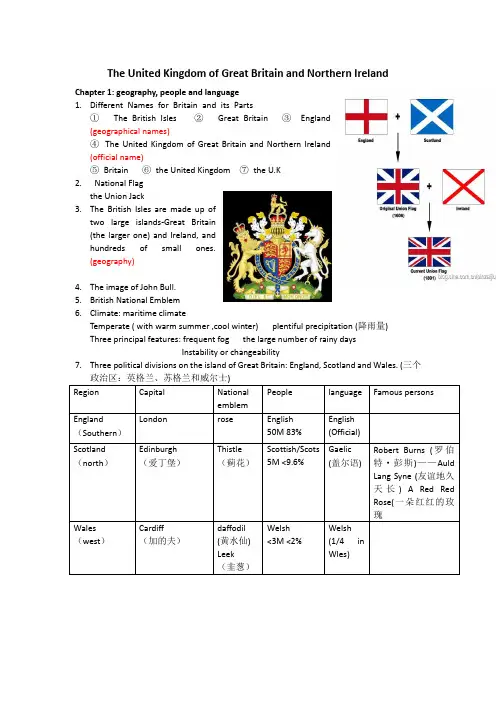
The United Kingdom of Great Britain and Northern IrelandChapter 1: geography, people and language 1. Different Names for Britain and its Parts① The British Isles ② Great Britain ③ England (geographical names)④ The United Kingdom of Great Britain and Northern Ireland (official name)⑤ Britain ⑥ the United Kingdom ⑦ the U.K 2. National Flagthe Union Jack3. The British Isles are made up oftwo large islands-Great Britain (the larger one) and Ireland, and hundreds of small ones. (geography)4. The image of John Bull.5. British National Emblem6. Climate: maritime climateTemperate ( with warm summer ,cool winter) plentiful precipitation (降雨量) Three principal features: frequent fog the large number of rainy days Instability or changeability7. Three political divisions on the island of Great Britain: England, Scotland and Wales. (三个政治区:英格兰、苏格兰和威尔士) Region Capital National emblem People language Famous personsEngland(Southern ) London rose English 50M 83%English (Official)Scotland (north )Edinburgh (爱丁堡)Thistle (蓟花)Scottish/Scots 5M <9.6% Gaelic (盖尔语)Robert Burns (罗伯特·彭斯)——Auld Lang Syne (友谊地久天长) A Red Red Rose(一朵红红的玫瑰 Wales(west ) Cardiff(加的夫)daffodil (黄水仙) Leek(韭葱)Welsh <3M <2%Welsh (1/4 in Wles)Northern Ireland Belfast(贝尔法斯特)Shamrock(三叶草)Northern Irish1.7M 1.8%English William Butler Yeats(威廉·巴特勒·叶芝)——When youare oldJames Joyce(詹姆斯·乔伊斯)——stream-of-consciousness(意识流)George Bernard Shaw(乔治·萧伯纳)Other people:3%(immigrants)补充:(1)Englandis the largest, most populous and most wealthiest part of the country.The River Thames originates in southwestern England. (英国第二长河)(2) Scotlandhas three natural zones (the Highlands in the north; the Central lowlands; the south Uplands) Capital: Edinburgh 苏格兰位于大不列颠的北部。

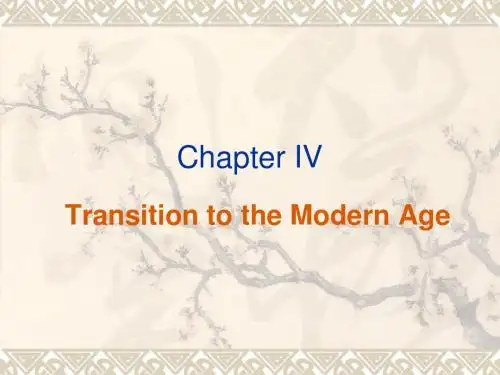
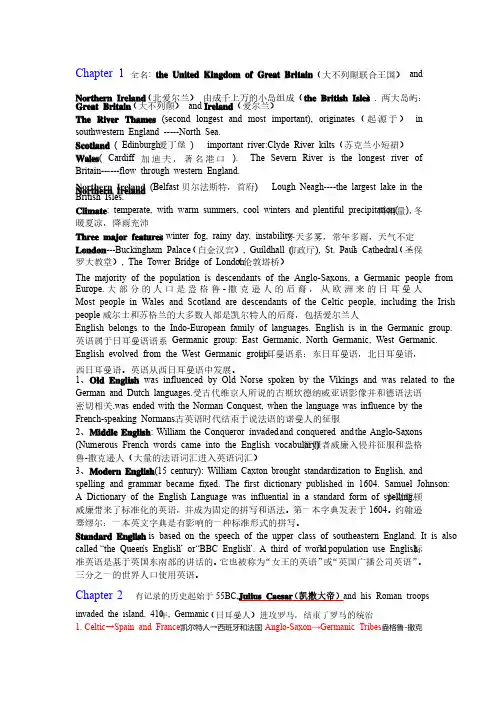
Chapter 1全名: the United Kingdom of Great Britain (大不列颠联合王国)(大不列颠联合王国) and Northern Ireland (北爱尔兰)(北爱尔兰) 由成千上万的小岛组成(the British Isles ). 两大岛屿:Great Britain (大不列颠)(大不列颠) and Ireland (爱尔兰)(爱尔兰)The River Thames (second longest and most important), originates (起源于) in southwestern England -----North Sea. Scotland ( Edinburgh 爱丁堡爱丁堡 ) important river:Clyde River kilts (苏克兰小短裙)(苏克兰小短裙) Wales ( Cardiff 加迪夫,著名港口 ). The Severn River is the longest river of Britain------flow through western England. Northern Ireland (Belfast 贝尔法斯特,首府) Lough Lough Neagh----the Neagh----the Neagh----the largest largest largest lake lake lake in in in the the British Isles. Climate : temperate, with warm summers, cool winters and plentiful precipitation(降雨量),冬暖夏凉,降雨充沛暖夏凉,降雨充沛Three major features : winter fog, rainy day, instability : winter fog, rainy day, instability 冬天多雾,常年多雨,天气不定冬天多雾,常年多雨,天气不定London ---Buckingham Palace (白金汉宫), Guildhall (市政厅), St. Paul ’s Cathedral (圣保(圣保罗大教堂), The Tower Bridge of London (伦敦塔桥)(伦敦塔桥)The majority of the population is descendants of the Anglo-Saxons, a Germanic people from Europe.大部分的人口是盎格鲁-撒克逊人的后裔,从欧洲来的日耳曼人 Most people in Wales and Scotland are descendants of the Celtic people, including the Irish people 威尔士和苏格兰的大多数人都是凯尔特人的后裔,包括爱尔兰人威尔士和苏格兰的大多数人都是凯尔特人的后裔,包括爱尔兰人English belongs to the Indo-European family of languages. English is in the Germanic group.英语属于日耳曼语语系英语属于日耳曼语语系 Germanic group: East Germanic, North Germanic, West Germanic. English evolved from the West Germanic group.日耳曼语系:东日耳曼语,北日耳曼语,西日耳曼语。
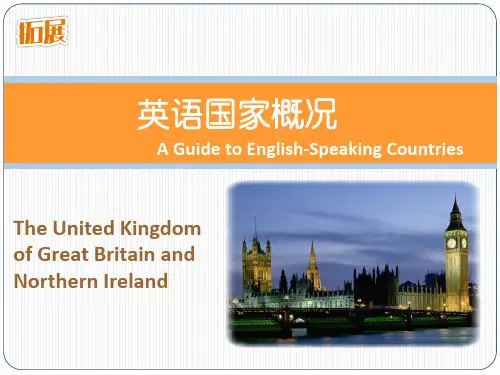
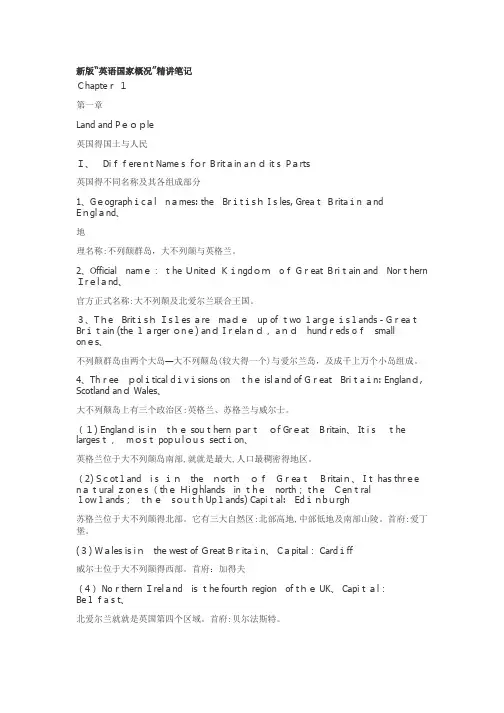
新版“英语国家概况”精讲笔记Chapter1第一章Land and People英国得国土与人民I、Different Names for Britain and its Parts英国得不同名称及其各组成部分1、Geographical names: the British Isles, GreatBritain andEngland、地理名称:不列颠群岛,大不列颠与英格兰。
2、Official name:the UnitedKingdomof Great Britain and Northern Ireland、官方正式名称:大不列颠及北爱尔兰联合王国。
3、The BritishIsles are madeup of two large islands-GreatBritain (the larger one) and Ireland, andhundreds ofsmallones、不列颠群岛由两个大岛—大不列颠岛(较大得一个)与爱尔兰岛,及成千上万个小岛组成。
4、Three political divisions on the island of Great Britain: England, Scotland and Wales、大不列颠岛上有三个政治区:英格兰、苏格兰与威尔士。
(1) England is inthe southern partof Great Britain、 It isthe largest,most populous section、英格兰位于大不列颠岛南部,就就是最大,人口最稠密得地区。
(2) Scotland isinthe northofGreatBritain、 It has three natural zones (theHighlands in thenorth; the Centrallowlands;thesouth Uplands) Capital: Edinburgh苏格兰位于大不列颠得北部。

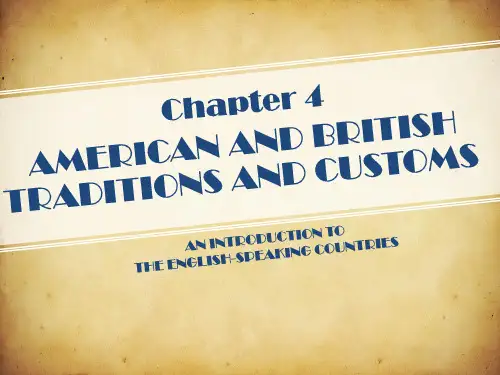
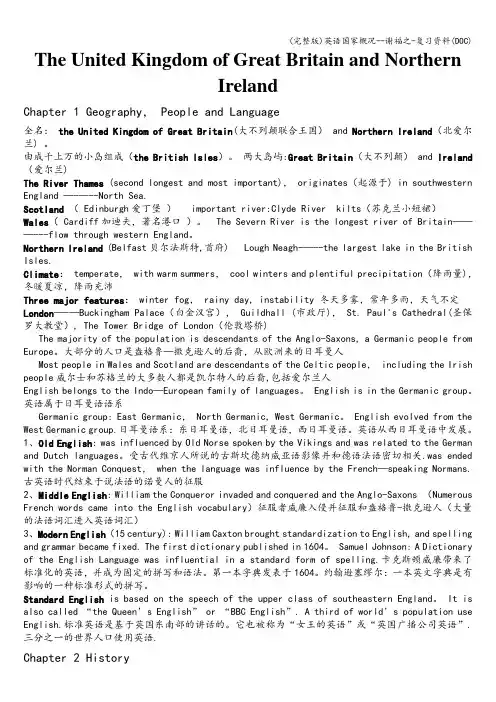
The United Kingdom of Great Britain and NorthernIrelandChapter 1 Geography, People and Language全名:the United Kingdom of Great Britain(大不列颠联合王国) and Northern Ireland(北爱尔兰) 。
由成千上万的小岛组成(the British Isles)。
两大岛屿:Great Britain(大不列颠) and Ireland (爱尔兰)The River Thames (second longest and most important), originates(起源于) in southwestern England —-—--North Sea.Scotland( Edinburgh爱丁堡) important river:Clyde River kilts(苏克兰小短裙)Wales( Cardiff加迪夫,著名港口)。
The Severn River is the longest river of Britain———---flow through western England。
Northern Ireland (Belfast贝尔法斯特,首府) Lough Neagh-—--the largest lake in the British Isles.Climate: temperate, with warm summers, cool winters and plentiful precipitation(降雨量),冬暖夏凉,降雨充沛Three major features: winter fog, rainy day, instability 冬天多雾,常年多雨,天气不定London—-—Buckingham Palace(白金汉宫), Guildhall (市政厅), St. Paul's Cathedral(圣保罗大教堂), The Tower Bridge of London(伦敦塔桥)The majority of the population is descendants of the Anglo-Saxons, a Germanic people from Europe。
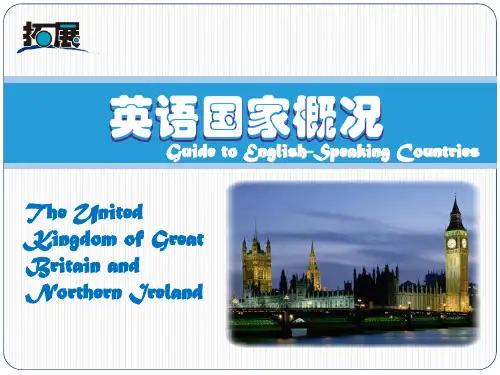
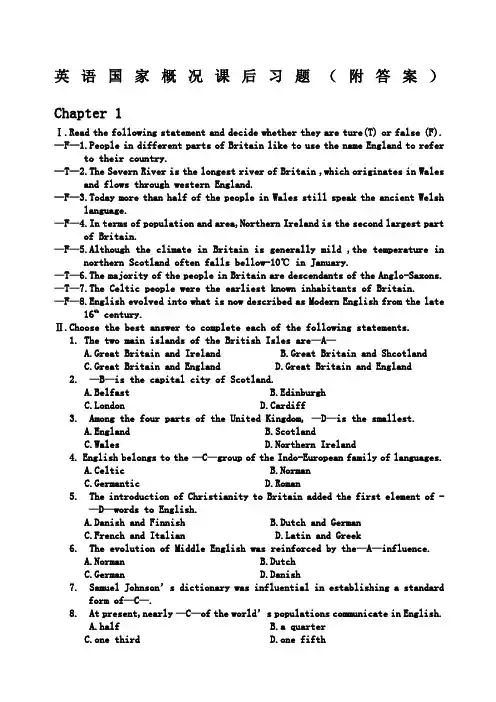
英语国家概况课后习题(附答案)Chapter 1Ⅰ.Read the following statement and decide whether they are ture(T) or false (F). —F—1.People in different parts of Britain like to use the name England to refer to their country.—T—2.The Severn River is the longest river of Britain ,which originates in Wales and flows through western England.—F—3.Today more than half of the people in Wales still speak the ancient Welsh language.—F—4.In terms of population and area,Northern Ireland is the second largest part of Britain.—F—5.Although the climate in Britain is generally mild ,the temperature in northern Scotland often falls bellow-10℃ in January.—T—6.The majority of the people in Britain are descendants of the Anglo-Saxons. —T—7.The Celtic people were the earliest known inhabitants of Britain. —F—8.English evolved into what is now described as Modern English from the late 16th century.Ⅱ.Choose the best answer to complete each of the following statements.1.The two main islands of the British Isles are—A—A.Great Britain and IrelandB.Great Britain and ShcotlandC.Great Britain and EnglandD.Great Britain and England2. —B—is the capital city of Scotland.A.BelfastB.EdinburghC.LondonD.Cardiff3. Among the four parts of the United Kingdom, —D—is the smallest.A.EnglandB.ScotlandC.WalesD.Northern Ireland4. English belongs to the —C—group of the Indo-European family of languages.A.CelticB.NormanC.GermanticD.Roman5. The introduction of Christianity to Britain added the first element of -—D—words to English.A.Danish and FinnishB.Dutch and GermanC.French and Italiantin and Greek6. The evolution of Middle English was reinforced by the—A—influence.A.NormanB.DutchC.GermanD.Danish7. Samuel Johnson’s dictionary was influential in establishing a standardform of—C—.8. At present,nearly —C—of the world’s populations communicate in English.A.halfB.a quarterC.one thirdD.one fifthⅢ.Give brief answers to the following questions.1.Why do tourist from all over the world like go to Scotland?2.How many periods can the development of the English language be dividedintoand what are they?3.Why did English become more important after the Black Death?Ⅳ.State your understanding of the following questions.1.Who are the British people?2.What is Standard English?Chapter 2Ⅰ.Read the following statements and decide whether they are true(T) or false(F). —T—1.Birtish history before 55 BC is basically undocumented.—T—2.The Anglo Saxon came to Britain in the 5th century.—F—3.The chief or king of the Anglo Saxon tribes exercised power at their own will.—T—4.The Viking began to attack the English coast in the 8th century. —T—5.Henry Ⅱ built up a large empire which included England and most of france. —F—6.The Magana Carta was designed to protect the rights of both the privileged class and townspeople.—F—7.The Hundred Years’War was a series of wars fought between the British and the Vikings for trade and territory.—T—8.In an effort to make a compromise between different religious factions,Queen Elizabeth Ⅰactually defended the fruit the Reformation. Ⅱ. Choose the best answer to complete each of the following statements.1. The—D—attack on Rome ended the Roman occupation in Britain in 410.A. NormanB. DanishC.CelticD.Germanic2. By the late 7th century, —D—became the dominant religion in England.A. Celtic ChristianityB. Anglo Saxons ChristianityC.Germanic ChristianityD. Roman Christianity3. The—C—marked the establishment of feudualism in England.A.Viking invasionsB. signing of the Magna CartaC.Norman ConquestD.adoption of common law4. The end of the Wars of the Roses led to the rule of—C—A.the House of ValoisB. the House of YorkC. the House of TudorD. the House of Lancaster5. The direct cause ofor the Reformation was King Henry Ⅷ’s effort to—A—.A.divorce his wifeB.break with RomeC.support the ProtestantD.declare his supreme power over the church6. The English Civil War broke out in1642 between —B—A.the Protestant and the PuritansB.the Royalist and the ParliamentarianC.the nobles and the peasantsD.the aristocrats and the Christians7. —A—was passed after the Glorious Revolution.A.The Bill of RightsB.The Act of SupremacyC.The Provisions of OxfordD.The Magna Carta8. The Industrail Revolution was accomplished in Britain by the middle of the—C—century.A.17thB.18thC.19thD.20thⅢ.Give brief answers to the following questions.1.What were Queen Victoria’s major achievements?2.What were the two camps in the World WarⅠ?3.Why did Britain cooperate closely with the Uinited States after World War Ⅱ?Ⅳ.State your understanding of the following questions.1.What were the results of the Industrail revolution in Britain?2.Explain the rise and fall of the British Empire.Chapter 3Ⅰ.Read the following statements and decide whether they are true(T) or false(F). —T—1.Conventions are regarded less important than the statutory law in the working of the England government.—F—2.The British monarchy has never been interrupted throughout the history. —F—3.In reality,the British King or Queen is the house of all government powers. —F—4.The British Parliament is the law making body of the Commonwealth of Nations.—F—5.The members of the House of Commons are appointed rather than elected. —T—6.The British Prime Minister is the leader of the minority party in Parliament.—F—7.Cabinet members are chosen by the Prime Minister from various political parties in Parliament.—T—8.The legal systems in England ,Wales,Scotland and Northern Ireland are much similar in terms of law,orgalizations and practice.Ⅱ. Choose the best answer to complete each of the following statements.1.The British government is characterized by a division of powers betweenthree of the following branchs EXCEPT the—C—.A.judiciaryB.legislatureC.monarchyD.executive2. The importance of the British monarchy can be seen in its effect on—D—.A.passing billsB.advising the gowernmentsC.political partiesD.public attitude3. As a revising chamber ,the House of Lords is expected to—B—the House ofCommons.A.rivalplementC.criticizeD.inspect4. —A—is at the center of the British political system.A.The CabinetB.The House of LordsC.The House of CommonsD.The Privy Council5. The main duty of the British Privy Council is to —B—.A.make decisionsB.give adviceC.pass billsD.supervise the Cabinet6. Generally speaking,the British Parliament operates on a —B—system.A.single partyB.two partyC.three partyD.multi party7. The politices of the Conservative Party are characterized by pragmatismand—D—.ernment interventionB.nationalization of enterprisesC.social reformD.a belief in individualiam8. In Britain,the parliamentary general election is held every—C—years.A.threeB.fourC.fiveD.sixⅢ.Give brief answers to the following questions.1.What are the three functions of the House of Commons?2.What kind of public image does the Liberal Democrats have in Britain?3.Why are independent candidates unlikely towin in the general elections? Ⅳ.State your understanding of the following questions.1.What do British electoral campaigns usually involves during the process ofa general election?2.What is the Commonwealth of Nations?Chapter 4Ⅰ.Read the following statement and decide whether they are ture(T) or false (F). —T—1.Britain was the first industrialized nation in the world.—T—2.The British economy experienced a relative decline during the postwar period.—F—3.Limited resources and high unemployment rate were persistent.—F—4.Thatcher’s revolution turned out to be agreat success in dealing with all the British economic and social problems.—T—5.The economic approach adopted by Tony Blair was different from that of the old Labor Party and the Conservetive Party.—T—6.Blair made the Bank of England independent in oder to separate politics from economic policy.—F—7.Britain is an important oil exporter since its oil industry has a long history.—T—8.Nuclear power is one of the major energy sources in Britain.Ⅱ.Choose the best answer to complete each of the following statements.1. The —A—in the early 1970s worsened an already stagnant economy in Britain.A.oil crisisB.high inflation ratesrge importsD.unemployment problem2. Of the following practices, —C—did not belong to Thatcher’s social welfare reform.A.reducing child benefitsB.shortening the period of unemployment benefitsC.reducing unemploymentD.lowering old age pension3. The Blair government was successful in the following aspect EXPECT—D—.A.limiting government spendingB.keeping inflation under controlC.reducing unemploymentD.reducing inequality4. Britain has devoted about—C—of its land area to agriculture.A.50%B.60%C.70%D.80%5. Britain’s important fishing areas include all the following EXCEPT—D—.A.the North SeaB.the English ChannelC.the area around the Irish coastD.the sea area between Britain and Ireland6. Coal mining industry in Britain provides—B—of the energy consumed in thecountry.A.one thirdB.one fourthC.one fifthD.two thirds7. The car industry in Britain is mostly —A—.A.foreign ownedB.state ownedC.joint ownedD.privately owned8. Of the following sectors in Britain, —C—has experienced spectacular growthsince the end of the World War Ⅱ.A.agricultureB.the energy industryC.the service sectorD.the manufacturing industryⅢ.Give brief answers to the following questions.1.What was the negative aspect of Thatcher’s reform in the early 1980s.2.What are the charactoristics of Britain’sagriculture?3.What happened to Britain’s beef industry in the mid 1990s?Ⅳ.State your understanding of the following questions.1.What were the major causes of Britain’s relative economic decline in the postwar period?2.Why do developed nations like Britian encourage the development of the service industry?Chapter 5Ⅰ.Read the following statement and decide whether they are ture(T) or false (F). —F—1.The Britain government has been responsible for education since the early 1800s.—F—cation inBritain is compulsory for all children between the ages of 6 and 15.—F—3.The National Curriculum is compulsory in both the states system and the independent system.—T—4.When children finish their schooling at 16,they are required to take a national GCSE examination.—T—5.Graduates from state schools in Britain have a less favorable chance to enter famous universities than those from independent schools.—F—6.The Times is the world oldest Sunday newspapers.—F—7.The BBC World Service broadcast only in English throughout the world. —T—8. Some British holidays are celebrated to mark important events in the Christian calendar,and some others are related to local customs and traditions.Ⅱ.Choose the best answer to complete each of the following statements.1. In Britain,the division between grammer schools and vocational schools was ended by the introduction of comprehensive schools in the —D—.A.1930sB.1940sC.1950sD.1960s2. Over—C—of British children receive primary and secondary education through the independent system.A.5%B.6%C.7%D.Partially funded 8%3. Partially funded by central government grants,most of the British universities receive the remaining funds from all the following sources EXCEPT—B—.A.tuition feesB.loansC.donationsD.corporate contributions4. To be admitted to the Open University, one needs—B—.A.some educational qualificatonsB.no educational qualificationsC.the General Certificate of Education Advanced level.D. the General Certificate of Secondary Education5. Among Britain’s quality press,the following newspapers are regarded asthe “Big Three”EXCEPT—C—.A.The TimesB.The GuardianC.The ObserverD.The Daily Telegraph6. Life On Earth is a kind of —C—program produced by the BBC is popularworldwide.A.radioB.dramaC.documentaryD.soap opera7. —D—is Britain’s top pay television provider.A.BSBB.SkyTVC.BBCD.BSkyB8. The following Christmas traditions are particularly British EXCEPT—A—.A.Trooping the ColorB.the Queen’s Christmas messageC.Boxing DayD.the Christmas pantomimeⅢ.Give brief answers to the following questions.1.What used to be the major functions of grammer schools and vocational schools in Britain.2.What kind of subjects do British comprehensive schools provide?3.In what ways do British universities enjoy complete academic freedom?4.What role does the media play in Britain leisure culture?Ⅳ.State your understanding of the following questions.1.What are the general features of Britain’s independent schools?2.What are the “Quality Press”and the “tabloids”in Britain?Chapter 6Ⅰ.Read the following statement and decide whether they are ture(T) or false (F).—F—1.The Canterbury Tales is representative work of the old English period. —T—2.The Renaissance is characterized by admiration of the Greek and Latin classic works.—T—3.As a great English peot,Alexander Pope also translated Homer’s Iliad. —F—4.Jhonathan Swift is probably the foremost prose satirist in the English language,and Robinson Crusoe is his masterpiece.—F—5.William Wordsworth amd Sumuel Taylor Colerdge brought the Romantic Movement to its height.—F—6.Lord Byron distinguished himself by the musical quality of his short poems,such as “Ode to the West Winds”.—F—7.Jane Austen is a well known novelist of the stream of consciousness school. —T—8.Joseph Conrad is classified as a forerunner of Modernism,which prevailed before World War Ⅱ.Ⅱ.Choose the best answer to complete each of the following statements.1. The most significant achievement of the English Renaissance is—B—.A.poetryB.dramaC.novelD.pamphlet2. —C—is viewed as Romantic poetry’s “Declaration of independence”.A. “I Wonder Lonely as a Cloud”B.Don JuanC.The preface to Lyrical BalladsD.Prometheus Unbound3.Of Dicken’s novels, —B—is considered most autobiographical.A.A Tale of Two CitiesB.Davied CopperfiedC.Oliver TwistD.Great Expectations4. —D—is a representative of English Critical Realism in the turn of the 19thcentury.A.Robert Louis SetevensonB.John MiltonC.Joseph ConardD.Thomas Hardy5. Of the following books, —C—is NOT written by Thomas Hardy.A.Jude the ObscureB.Tess of the d’UrbervillesC.Adam BedeD.The Return of the Native6. —A—is not included in the modernist group.A.Oscar WildeB.Virginia WoolfC.William Bulter YeatsD.T.S.Eliot7. Of the following writers, —B— is NOT a Nobel Prize winner.A.Samuel BeckettB.James JoyceC.William GoldingD.V.S.Naipual8. Waiting for Godot is written by—A—.A.Samuel BeckettB.Geroge OrwellC. William GoldingwranceⅢ.Give brief answers to the following questions.1.What are the three catergries of Shakespeare’s plays and their representatives?2.What is Critical Realism?3.What are the two new literary trends prevailing at the end of 19th century?4.What is the stream of consciousness?Ⅳ.State your understanding of the following questions.1.What is Romanticism?2.What are the characteristics of English literauture in the 20th century? Chapter 7Ⅰ.Read the following statement and decide whether they are ture(T) or false (F). —F—1.The Republic of Ireland occupies the entire area of the island of Ireland. —F—2.The earliest inhabitants in Ireland were Celtic tribes from Europe. —F—3.In the 1800s, Ireland gained in prosperity because it became a part of Britain.—T—4.In the 1930s, Ireland was not indeed a republic, but belonged to the British Commonwealth of Nations.—F—5.Ireland’s economy wasn’t affected by World War Ⅱ because it remained neutral during the war.—F—6.In 1949, Britain recognized the independence of the Irish Republic and returned the six northern counties.—F—7.English is the only official language in Ireland because the majority of people speak it as their mother tongue.—T—8.Catholicism in Ireland is more than a mere matter of private faith, but of public identity.Ⅱ.Choose the best answer to complete each of the following statements.1. --B-- established a unified Irish culture and language in the 6th century BC.A. Hunter-gatherers from BritainB. Celtic tribesC. British invadersD. The Vikings2. Divergent views about --C--resulted in the Irish Civil War.A. the Act of UnionB. the Unilateral Declaration of IndependenceC. the Anglo-Irish TreatyD. the Anglo-Irish Agreement3. --C---was the first Irish President to visit Queen Elizabeth Ⅱ.A. Eamon de ValeraB. John A. CostelloC. Mary RobinsonD. Albert Reynolds4. ---D--brought Anglo-Irish relations to a new height.A. The British recognition of the Irish RepublicB. The signing of the Downing Street DeclarationC. The signing of the Belfast AgreementD. The IRA’s formal declaration of the disarmament in 20055. In Ireland, the head of state is--B---A. the Prime MinisterB. the PresidentC. the British monarchD. the General Governor6. ---C---has been the dominant party in Ireland since 1930s and supportspeaceful reunification of the island of Ireland.A. Fine GaelB. The Labor PartyC. Fianna FailD. The Progressive Democrats7. Emigration in Ireland started since the --A--A. medieval periodB. 17th centuryC. Great Potato FamineD. early 18th century8. Ireland now has a --B-- economy.A. agriculture-basedB. knowledge-basedC. industry-basedD. foreign investment-basedⅢ.Give brief answers to the following questions.1. Why was Cork given the nickname “the Rebel County”?2. Who were the first groups of people that came to Ireland?3. Why did Ireland remain neutral in World War Ⅱ?Ⅳ.State your understanding of the following questions.1. What is the significance of the following documents: the Act of Union, the Anglo-Irish Treaty, the Anglo-Irish Agreement and the Belfast Agreement?2. What are the goals of the main political parties in Ireland?Chapter 8Ⅰ.Read the following statement and decide whether they are ture(T) or false (F). —F—1.The eastern highlands formed by the Appalachian Range hold one-third of the country’s continental territory.—T—2.The climate in the United States can be classified as temperate, with some mild subtropical and tropical zones.—T—3.A 50-centimeter rainfall line runs through the middle of the United States. —T—4.New York is composed of five boroughs, including Manhattan, Brooklyn, the Bronx, Staten Island and Queens.—F—5.San Francisco is the second largest city after New York and the world-famous Hollywood is located here.—T—6.During the 1830s and the 1840s, many Northern Europeans and Irish immigrants came to America.—T—7.Almost half of the immigrants coming to the United States in the 1980s were Asians.—T—8.Basic American cultural values are freedom, equality and desire to work hard for a higher standard of living.Ⅱ.Choose the best answer to complete each of the following statements.1. The U.S. lies in --B--North America, with Canada to the north, Mexico to the south, the Atlantic to its ----and the Pacific to its -----.A. northern, east, westB. central, east, westC. southern, west, eastD. western, west, east2. The continental United States has--C---states.A. 50B. 49C. 48D. 353. The state of --A--- is the largest in area of all the U.S. states.A. AlaskaB. HawaiiC. TexasD. Florida4. The longest river in the U.S. is ---B---A. the Missouri RiverB. the Mississippi RiverC. the Ohio RiverD. the Lake Itasca5. Some of the world-famous universities like Harvard, Yale and MIT arelocated in--C--.A. the SouthB. the WestC. New EnglandD. the Midwest6. San Francisco, Los Angeles and San Diego all belong to --D--A. MontanaB. UtahC. MaineD. California7. The Immigration Act of 1924 restricted further immigration into the UnitedStates, particularly from--A----.A. EuropeB. AsiaC. AfricaD. South America8. The characteristics of the dominant American culture are--D-A. English-speaking, Northern European, Roman Catholic and middle-classB. English-speaking, Western European, Roman Catholic and upper-classC. English-speaking, Northern European, Protestant and upper-classD. English-speaking, Western European, Protestant and middle-classⅢ.Give brief answers to the following questions.1. How is the American population distributed?2. Why was the Immigration Act of 1924 instituted?Ⅳ.State your understanding of the following questions.1. Why is the United States regarded as a “melting pot”and a “salad bowl”?2. What do you think is the best way to help assimilation in a multiculturalsociety?Chapter 9Ⅰ.Read the following statement and decide whether they are ture(T) or false (F).—T—1.American was named after Amerigo Vespucci,who arrived on the new continent after Columbus.—F—2.The Second Continental Congress was held in Phiadelphia,and the Continental Army and Navy was established under the command of ThomasJerfferson.—T—3.The Amemrican Civil War not only put an end to slavery,but also make American a single,indivisible nation.—F—4.Most American people approved of the Vietnam War.—T—5.In1990,American troops and the troops from allied nations took joint military action in order to drive Iraqi troops out of Kuwait.—F—6.According to the American government,Saddam Hussein and Osama bin Laden were responsible for the terrorist event on Septemble11,2001.—T—7.The Bush administration regarded Iraq a nation among the “axis of the evil”.—F—8.On March 20,2003,American and United Nations’troops, supposed by several other countries,began an invasion of Iraq.Ⅱ.Choose the best answer to complete each of the following statements.1. The first successful English conoly in North America was foundedat—C—in——.A.Jamestown,LouisianaB.Boston, MassachusettsC.Jamestown,VirginiaD.Plymouth,Gergia2. The Seven Years’War occurred between—C—.A.the French and the American IndiansB.the French and the SpanishC.the French and the BritishD. the British and the American Indians3. “No taxation without representation”was the rallying slogan of—D—.A.the settlers of VirginiaB.the people of PennsylvaniaC.the colonists in New EnglandD.the people of the 13 colonies4. In May 1775, —B—was held in Phiadelphia and began to assume the functionsof a provisional government.A.the First Continental CongressB.the Second Continental CongressC.the Boston Tea PartyD.the Congress of Confederation5. Abraham Lincoln issued the —C—to grant freedom to all slaves.A.Declaration of IndependenceB.ConstitutionC.Emancipation ProclamationD.Bill of Rights6. The policy of the United States was —A—at the beginning of the two WorldWars.A.nuetralityB.full involvementC.partial involvementD.appeasement7. President —C— introduced the NⅡew Deal to deal with the problems of theGreat Depression.A.WilsonB.TrumanC.RooseveltD.Kennedy8. The Vietanam War was a long time suffering for Americans,and its continuedthroughout the terms of president—D—.A.Johnson,Nixon and FordB.Truman,Eisenhower and KennedyC.Kennedy,Johnson and NixonD.Eisenhower,kennedy and JohnsonⅢ.Give brief answers to the following questions.1.Why did American change its policy and enter World War Ⅱ?2.What were Nixon’s well known contributions during his presidency?3.What were the measure s of Reagan’s economic program?Ⅳ.State your understanding of the following questions.1.What was the course of the American Civil War?2.What made the United States a powerful country by the end of World War Ⅱ? Chapter 10Ⅰ.Read the following statement and decide whether they are true(T) or false (F). —F—1.The Bill of Right was written into the Constitution in 1787.—T—2.The form of the American government is based on three main principles: federalism, the separation of powers and respect for the Constitution and rule of law.—F—3.The US Congress consists of two houses: the House of Commons and the Houseof Lords.—T—4.The judicial branch of the US federal government consists of a series of courts: the supreme court, the courts of appeals and the district courts.—F—5.The Democratic Party is conservative in terms of its ideology.—T—6.The American presidential campaigns adhere to the “winner-takes-all”practice.—F—7.The American foreign policy throughout World War 2 was neutrality.—T—8.The American foreign policy during the Cold War period was containment and intervention.Ⅱ.Choose the best answer to complete each of the following statements.1.The US.Constitution came into effect in –B--A. 1787B. 1789C. 1791D.17932. The Constitution of the United States --C--A. gives the most power to CongressB. gives the most power to thepresidentC. tries to give each branch enough power to balance the othersD.gives the most power to the Supreme Court3.The Bill of Right –B--A. defines the rights of Congress and the rights of the PresidentB. guarantees citizens of the US specific individual rights and freedomC. is part of the Declaration of IndependenceD. has norelationship with the Constitution.4.The terms for a Senator and Representative are __D_ and ___ yearsreapectively.A. 2;4B.2;3C. 2;6D.6;25. All the following can make legislative proposals EXCEPT –C--A. the senatorB. the RepresentativeC. the secretary of stateD. the president6.The following are all powers of the President EXCEPT CA. vetoing any bills passed by CongressB. appointing federaljudges when vacancies occurC. making lawsD.issuing executive orders7. The Supreme Court is composed of __D_ justicesA. 6B. 7C. 8D.98. The president is directly voted into office by _C__A. all citizens of AmericaB. the citizens over 18 years oldC. electors elected by the votersD. the senators and therepresentativesⅢ.Give brief answers to the following questions.1.what are the two characteristics of the us constitution?2.what are the qualifications for a senator and a representative respectively?3.what are the major powers of the Supreme Court?4.what are the differences between the Democrats and the Republicans in termsof political ideology.Ⅳ.State your understanding of the following questions.1.How is the American President voted into office? What are your ideas aboutthe American election?2.what was President Eisenhower’s foreign policy and what were the consequences?Chapter 11Ⅰ.Read the following statement and decide whether they are true(T) or false (F).—T—1.America is the world’s largest industrial nation.—T—2.In the US Constitution ,the recognition of the importance of ‘intellectual property’ could be identified.—F—3.Although slavery was abolished as a result of the Civil War, the owners of plantations in the South made more profits from selling their agriculturalproducts.—F—4. President Roosevelt’s New Deal had little effect in dealing with the economic crisis in the early 1930s—F—5. The 1960s was a period of consolidation for the American business.—T—6. American agriculture exports outweigh imports, leaving a surplus in the agricultural balance of trade.—T—7. Auto production is one of the important sectors in American manufacturing industry.—F—8. The growth and decline of the American foreign trade has little to do with the world economy.Ⅱ.Choose the best answer to complete each of the following statements.1.America produces a major portion of the world’s products in the followingfields EXCEPT __C_A. machineryB. automobilesC. oreD. chemicals2. The modern American economy progressed from___ to____, and then to __C__A. a colonial economy, a handcraft economy, an industrial economyB. a farming economy, a handcraft economy, an industrial economyC. a colonial economy, a farming economy, an industrial economyD. a handcraft economy, a farming economy, an industrial economy3. Chartered companies were NOT granted the _D__ by the British King or Queen.A. political authorityB. economic rightsC. judicial authorityD. diplomatic authority4. __D__ urged the federal government to establish a national bank.A. George WashingtonB. President RooseveltC. Abraham LincolnD. Alexander Hamilton5. The following inventions took place during the ‘second industrialrevolution’ EXCEPT_C__A. typewriterB. telephoneC. electric lightD. refrigerator。
英语国家概况-谢福之-修正-选择题1-13章Chapter 11.The two main islands of the British Isles are .A. Great Britain and IrelandB. Great Britain and ScotlandC. Great Britain and WalesD. Great Britain and England2.is the capital city of Scotland.A. BelfastB. EdinburghC. AberdeenD. Cardiff3.Among the four parts of the United Kingdom, is the smallest.A. EnglandB. ScotlandC. WalesD. Northern Ireland4.English belongs to the group of Indo-European family of languages.A. CelticB. Indo-IranianC. GermanicD. Roman5.The introduction of Christianity to Britain added the first element of words toEnglish.A. Danish and FinnishB. Dutch and GermanC. French and ItalianD. Latin and Greek6.The evolution of Middle English was reinforced by the influence.A. NormanB. DutchC. GermanD. Danish7.S amuel Johnson’s dictionary was influential in establishing a standard form of .A. grammarB. handwritingC. spellingD. pronunciation8.At present, nearly o f the world’s population communicate inEnglish.A. halfB. a quarterC. one thirdD. one fifth Chapter 2 p291. The attack on Rome ended the Roman occupation in Britain in 410.A. NormanB. DanishC. CelticD. Germanic2.By the late 7th century, became the dominant religion in England.A. Celtic ChristianityB. Anglo-Saxon ChristianityC. Germanic ChristianityD. Roman Christianity3.The marked the establishment of feudalism in England.A. Viking invasionB. signing of the Magna CartaC. Norman ConquestD. Adoption of common law4.The end of the Wars of the Roses led to the rule of .A. the House of ValoisB. the House of YorkC. the House of TudorD. the House of Lancaster5.The direct cause for the Religious Reformation was King Henr y VIII’s effort to .A. divorce his wifeB. break with RomeC. support the ProtestantsD. declare his supreme power over the church6.The English Civil War broke out in 1642 between .A. Protestants and PuritansB. Royalists and ParliamentariansC. nobles and peasantsD. aristocrats and Christians7.was passed after the Glorious Revolution.A. Bill of RightsB. Act of SupremacyC. Provisions of OxfordD. Magna Carta8.The Industrial Revolution was accomplished in Britain by the middle of the century.A. 17thB. 18thC. 19thD. 20th1-13章Chapter 3 p411. The British government is characterized by a division of powers between three of thefollowing branches with the exception of the .A. judiciaryB. legislatureC. monarchyD. executive2.The importance of the British monarchy can be seen in its effect on .A. passing the billsB. advising the governmentC. political partiesD. public attitude3.As a revising chamber, the House of Lords is expected to the House of Commons.A. rivalB. complementC. criticizeD. inspect4.is at the center of the British political system.A. The CabinetB. The House of LordsC. The House of CommonsD. The Privy Council5.The main duty of the British Privy Council is to .A. make decisionsB. give adviceC. pass billsD. supervise the Cabinet6.Generally speaking, the British Parliament operates on a system.A. single-partyB. two-partyC. three-partyD. multi-party7.The policies of the Conservative Party are characterized by pragmatism and .A. government interventionB. nationalization of enterprisesC. social reformD. a belief in individualism8.In Britain, the parliamentary general election is held every years.A. threeB. fourC. fiveD. sixChapter 4 p511. The in the early 1970s worsened an already stagnant economy in Britain.A. oil crisisB. high inflation ratesC. large importsD. unemployment problem2.Of the following practices, does not belong to Thatcher’s social welfare reform.A. reducing child benefitsB. shortening the unemployment benefits periodC. reducing the unemploymentD. lowering old age pensions3.The Blair government has been successful in all the following aspects except .A. limiting government spendingB. keeping inflation under controlC. reducing unemploymentD. reducing inequality4.Britain has devoted of its land area to agriculture.A. 54%B. 64%C. 74%D.84%5.Britain’s important fishing areas include all the following except .A. the North SeaB. the English ChannelC. The sea area around IrelandD. The sea area between Britain andIreland6.Coal mining industry in Britain provides of the energy consumed in the country.A. 1/3B. 1/4C. 1/5D. 2/37.The car industry in Britain in mostly .A. foreign-ownedB. state-ownedC. joint-ventureD.privately-owned1-13章8.Of the following sectors in Britain, has experienced spectacular growth since theend of Word War II.A. agricultureB. the energy industryC.the service sectorD. manufacturingindustryChapter 5 p631. In Britain, the division between grammar schools and vocational schools were ended by theintroduction of comprehensive schools in the .A. 1930sB. 1940sC. 1950sD. 1960s2.About of British children receive primary and secondary education through theindependent system.A. 5%B. 6%C. 7%D. 8%3.Partially funded by central government grants, the British universities receive their remainingfunds from all the following sources except .A. tuition feesB. loansC. donationsD. corporate contributions4.To be admitted to the Open University, one need .A. some educational qualificationsB. no educational qualificationsC. General Certificate of Education-AdvancedD. General National Vocational Qualifications5.Among Britain’s quality press, the following newspapers are regarded as the “Big Three” withthe exception of .A. The TimesB. The GuardianC. The ObserverD. The Daily Telegraph6.Life on Earth is a kind of program produced by the BBC and is popular among 500million viewers worldwide.A. featureB. dramaC. documentaryD. soap opera7.is Britain’s top pay television provider.A. BSBB. SkyTVC. BBCD. BSkyB8.The following Christmas traditions are particularly British except .A. Trooping the ColorB. Queen’s Christmas messageC. Boxing DayD. Christmas pantomimeChapter 6 p781.The most significant achievement of the English Renaissance is .A.poetryB. dramaC. novelD. pamphlet2. is viewed as Romantic poetry’s “Declaration of Independence”.A.”I Wonder Lonely as a Cloud”B.Don JuanC.T he preface to Lyrical BalladsD.Prometheus Unbound3.Of Dickens’novels, ________ is considered most autobiographical.A.A Tale of Two CitiesB.David CopperfieldC.Oliver TwistD.Great Expectations4.________ is a representative of English critical realism in the 19th century.A.Robert Louis StevensonB.John MiltonC.Joseph ConradD.Thomas Hardy5.Of the following books, is NOT written by Thomas Hardy.A.Jude the ObscureB.Tess of the d’Uebervilles1-13章C.A dam BedeD.the return of the native6.is NOT included in the modernist group.A.Wscar WildeB.Virginia WoolfC.William Butler YeatsD.T.S.Eliot7.Of the following writers, is NOT a Nobel Prize winner.A.Samuel BeckettB.James JoyceC.William GoldingD.V.S Naipaul8.Waiting for Godot is written by .A.Samuel BeckettB.George OrwellC.William GoldingwrenceChapter 8 p1101. The U. S. lies in North America, with Canada to the north, Mexico to the south, theAtlantic to its and the Pacific to its .A. northern, east, westB. central, east, westC. southern, west, eastD. western, east, west2. The continental United States has statesA. 50B. 49C. 48D. 353.The state of is the largest in area of all the states.A. AlaskaB. HawaiiC. TexasD. Florida4.The largest river in the U. S. is .A. the Missouri RiverB. the Mississippi RiverC. the Ohio RiverD. the Colorado River5.Some of the world famous universities like Harvard, Yale and MIT are located in .A. the SouthB. the WestC. New EnglandD. the Midwest6.San Francisco, Los Angeles and San Diego all belong to .A. MontanaB. UtahC. MaineD.California7.The Immigrants Act of 1924 restricted the further immigration into the United States,particularly from .A. EuropeB. AsiaC. AfricaD. South America8.The characteristic of the dominant American culture is .A. English-speaking, northern European, Roman Catholic and middle-classB. English-speaking, western European, Roman Catholic and upper-classC. English-speaking, northern European, Protestant and upper-classD. English-speaking, western European, Protestant and middle-classChapter 9 p1221. The first successful English colony in North America was founded at in .A. Jamestown, LouisianaB. Boston, MassachusettsC. Jamestown, VirginiaD. Plymouth, Georgia2.The Seven Years’ War occurred between the .A. the French and the American IndiansB.the French and the SpanishC. the French and the BritishD. the British and the American Indians3.“No taxation without representation” wa s the rallying slogan of .1-13章A. the settlers of VirginiaB. the people of PennsylvaniaC. the colonists in New EnglandD. the people of the 13 colonies4.In May 1775, was held in Philadelphia and began to assume the functions of anational government.A. the First Continental CongressB. the Second Continental CongressC. the Boston Tea PartyD. the Congress of Confederation5.Abraham Lincoln issued to grant freedom to all slaves.A. Declaration of IndependenceB. ConstitutionC. Emancipation ProclamationD. Bill of Rights6.The policy of the United States was at the beginning of the two world wars.A. neutralityB. full involvementC. partial involvementD. appeasement7.President applied New Deal to deal with the problems of the Great Depression.A. WilsonB. TrumanC. RooseveltD. Kennedy8.The Vietnam War was a long-time suffering for Americans, and it continued throughout theterms of Presidents .A. Johnson, Nixon and FordB. Truman, Eisenhower and KennedyC. Kennedy, Johnson and NixonD. Eisenhower, Kennedy and Johnson Chapter 10 p1361. The U. S. Constitution came into effect in .A. 1787B. 1789C. 1791D. 17932.The Constitution of the United States .A. gives the most power to CongressB. gives the most power to the PresidentC. tries to give each branch enough power to balance the othersD. gives the most power to the Supreme Court3.The Bill of Rights .A. defines the rights of Congress and the rights of the PresidentB. guarantees citizens of the United States specific individual rights and freedomsC. is part of the Declaration of IndependenceD. has no relationship with the Constitution4.The terms for a Senator and Representative are and yearsrespectively.A. two, fourB. two, threeC. two, sixD. six, two5.All the following except cannot make legislative proposal.A. the SenatorB. the RepresentativeC. the Secretary of StateD. the President6.The following except are all powers of the President.A. vetoing any bills passed by CongressB. appointing federal judges when vacancies occurC. making lawsD. issuing executive orders7.The Supreme Court is composed of justices.A. sixB. sevenC. eightD. nine8.The President is directly voted into office by .1-13章A. all citizens of AmericaB. the citizens over 18 years oldC. electors elected by the votersD. the senators and representatives Chapter 11 p1471. America produces a major portion of the world’s products in the following fieldsexcept .A. machineryB. automobilesC. oreD. chemicals2.The modern American economy progressed from to , and eventually,to .A. colonial economy, handcraft economy, industrial economyB. farming economy, handcraft economy, industrial economyC. colonial economy, farming economy, industrial economyD. handcraft economy, farming economy, industrial economy3.Chartered companies were NOT granted the by the British King or Queen.A. political authorityB. economic rightsC. judicial authorityD. diplomatic authority4.urged the federal government to establish a national bank.A. George WashingtonB. President RooseveltC. Abraham LincolnD. Alexander Hamilton5.The following i nventions took place during the “second industrial revolution” except .A. typewriterB. telephoneC. electric lightD. refrigerator6.President Johnson tried to build a “Great Society” by introducing various programs like thefollowing except .A. MedicareB. Food StampsC. Education InitiativesD. Unemployment Pension7.The following statements are all true except .A. Agribusinesses reflect the big, corporate nature of many farmenterprises.B. Agribusinesses maintain a balanced trade pattern between agricultural imports andexports.C. Agribusinesses range from one-family corporations to multinational firms.D. Agribusinesses include a variety of farm businesses and structures.8. Employment in the sector has been increasing in the U.S. since the 1970s.A. serviceB. agricultureC. manufacturingD. high-tect Chapter 12 p1601. Formal education in the United States consists of , secondary and higher education.A. kindergartenB. publicC. elementaryD. private2.Of the following subjects, are NOT offered to elementary school students.A. mathematics and languagesB. politics and business educationC. science and social studiesD. music and physical education3.Higher education in the United States began with the founding of .A. Yale UniversityB. Harvard UniversityC. Princeton UniversityD. New York University4.Of the following, are NOT among the categories of American higher education.1-13章A. universities and collegesB. research institutionsC. technical institutionsD. community colleges5.To get a bachelor’s degree, all undergraduate students are required to do the followingexcept .A. attending lectures and completing assignmentsB. passing examinationsC. working for communitiesD. earning a certain number of credits6.is sold especially to the upper or upper-middle class and it has a reputation for itsserious attitude and great bulk.A. The Washington PostB. The New York TimesC. Los Angeles TimesD. New York Daily News7.Of the following, is NOT among the three major radio and TV networks in America.A. the National Broadcasting System (NBS)B. the Public Broadcasting Service (PBS)C. the Columbia Broadcasting System (CBS)D. the American Broadcasting System (ABS)8.The National Day of the United States falls on .A.June 4thB. July 4thC. June 14thD. July 14th Chapter 13 p1761.Of the following writers,_______are from the Colonial and Revolutionary Periods.A.Benjamin Franklin and Edgar Allan PoeB.Edgar Allan and Jonathan EdwardsC.Benjamin Franklin and Jonathan EdwardsD.Edgar Allan and Washington Irving2._______is regarded as the “father of American and literature”.A.James Fenimore CooperB.Ralph Waldo EmersonC.Thomas JeffsonD.Washington Irving3.Of the following,_______is considered Herman Melv ille’s masterpiece.A.The last of the MohicansB.The Legend of Sleepy HollowC.Moby DickD.Daisy Miller4.Of the following,_______is NOT characteristic of Mark Twain’s works.A.clloquial speechB.a sense of humorC.a realistic viewD.an idealistic view5.Of the following writers,_______is NOT includeed in the group of naturalists.A.Stephen CranceB.Frank NorrisC.Theodore DreiserD.Herman Melville6.F.Scott Fitzgerald’s finest novel is _______,and its theme is about _______.A.The Great Gatsby,the American DreamB.Tender Is the Night,loveC.Tales of the Jazz Age,the loss of oneselfD.The Beautiful and Damned,the evil of human nature7.Of the following writers,_______is NOT a Nobel Prize winner.A.Alice WalkerB.Ernest HemingwayC.William FaulknerD.Eugene O’Neill8._______is the first African-American winner of the Nobel Prize for Literature.。